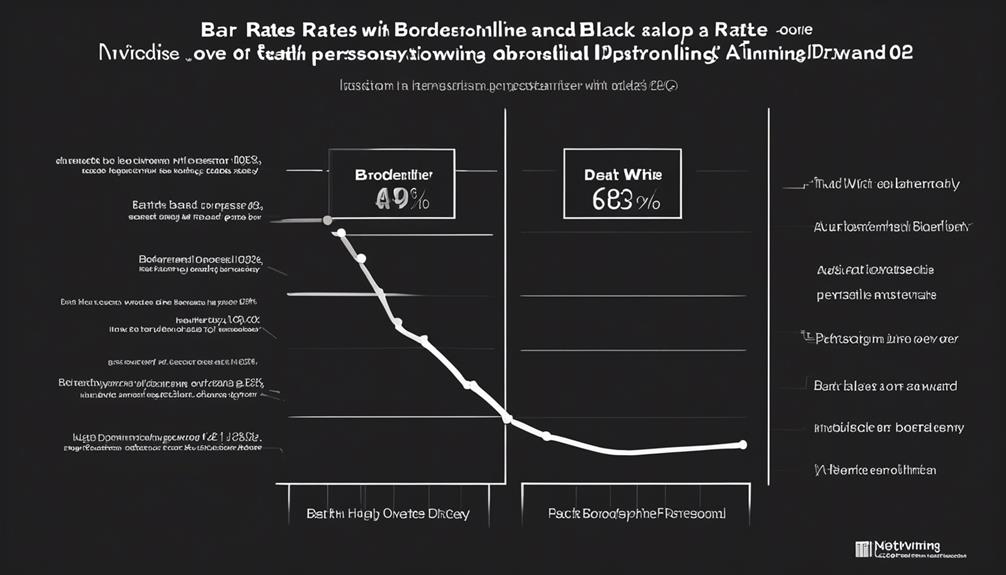Researching the connection between Borderline Personality Disorder (BPD) and using the silent treatment reveals that approximately 70% of people diagnosed with BPD exhibit this behavior as a coping mechanism when they are distressed. Recognizing the main causes of this type of communication and how it affects relationships can shed light on successful approaches to handling these scenarios.
By exploring the complexities of silent treatment in BPD, we can uncover valuable insights into fostering healthier interactions and supporting individuals in navigating these challenging dynamics.
Key Takeaways
- Silent treatment common in BPD relationships, impacting emotional well-being.
- Therapy crucial for addressing silent treatment impact and developing coping strategies.
- Open communication, setting boundaries, and self-care essential coping strategies.
- Active listening and validation foster understanding and connection in BPD relationships.
Impact of BPD Silent Treatment
Experiencing the silent treatment in Borderline Personality Disorder (BPD) relationships can profoundly impact emotional well-being and communication dynamics. Individuals with BPD often resort to the silent treatment due to their fear of abandonment and struggles with emotional regulation. This behavior can evoke feelings of guilt, confusion, and frustration in their partners, leading to strained communication and potential breakdowns in relationships. The fear of rejection underlying the silent treatment can create a cycle of conflict and distance, making it challenging to establish healthy connections.
Therapy plays a crucial role in addressing the impact of silent treatment within BPD relationships. Through therapy, individuals can explore the root causes of their fear of abandonment and develop coping strategies to manage their emotions more effectively. By fostering self-awareness and improving emotional regulation skills, individuals with BPD can work towards healthier communication patterns and stronger relationships. Seeking support from mental health professionals can provide the necessary guidance and tools to navigate the complexities of BPD and the challenges posed by the silent treatment.
Coping Strategies for Silent Treatment

When navigating the challenges of silent treatment in Borderline Personality Disorder (BPD) relationships, implementing open communication and validating emotions can be effective coping strategies. In such situations, it's crucial to address the issue with empathy and understanding.
Here are some strategies to cope with silent treatment in BPD relationships:
- Setting clear boundaries and avoiding defensiveness can help manage silent treatment dynamics.
- Prioritizing self-care and seeking professional help when needed are essential for individuals dealing with silent treatment in BPD.
- Encouraging empathy and practicing active listening can aid in navigating the challenges posed by silent treatment behaviors.
- Understanding the underlying reasons behind silent treatment and practicing patience can contribute to improved relationship dynamics.
- Recognizing the importance of validating emotions and communicating openly can foster healthier interactions when facing silent treatment in BPD relationships.
Communication Tips for BPD Relationships
Navigating communication in Borderline Personality Disorder (BPD) relationships requires a deep understanding of how active listening and validation can play a crucial role in fostering open dialogue and emotional connection.
When communicating with a loved one who's BPD, it's essential to practice active listening to comprehend the emotions underlying their silence. By acknowledging and validating their feelings, you create a safe space for honest communication to flourish.
Avoid the temptation to react defensively to the silent treatment; instead, focus on creating an environment conducive to dialogue. Using 'I' statements can help express your feelings without provoking defensiveness and encourage reciprocal sharing.
Seeking therapy, particularly Dialectical Behavior Therapy (DBT) or group therapy, can provide valuable tools and techniques tailored to the unique dynamics of BPD relationships.
Through these strategies, communication can become a bridge to understanding and connection in BPD relationships.
Understanding the Dynamics of Silent Treatment

Understanding the dynamics of silent treatment involves delving into the root causes behind this behavior in BPD relationships. Silent treatment in BPD can be a complex interplay of various factors, including fear of rejection, challenges with emotional regulation, and a deep-seated fear of abandonment. To navigate this intricate issue effectively, consider the following insights:
- Loved Ones Impact: The loved ones of individuals with BPD can often bear the brunt of silent treatment, experiencing feelings of confusion and guilt.
- BPD Symptoms: Silent treatment can be a manifestation of the core symptoms of BPD, such as intense emotions and unstable relationships.
- Therapy (DBT): Dialectical Behavior Therapy (DBT) can be instrumental in helping individuals with BPD learn healthier coping mechanisms and improve communication skills.
- False Self: The creation of a false self through silent treatment can hinder authentic connection and perpetuate relationship difficulties.
- Communication Breakdowns: The prolonged use of silent treatment can lead to significant strain in relationships, resulting in breakdowns in communication.
Seeking Professional Help for BPD
In addressing the complexities of BPD and its impact on relationships, seeking professional help can offer individuals with BPD valuable tools and support to navigate their symptoms effectively. Therapy, such as Dialectical Behavior Therapy (DBT) or Cognitive Behavioral Therapy (CBT), can provide coping strategies to manage the intense mood swings and difficulty managing emotions commonly experienced in BPD.
These therapeutic approaches can also help individuals with BPD address underlying issues contributing to behaviors like silent treatment, fostering improved communication skills and emotional regulation. By working with mental health professionals, individuals with BPD can create a supportive environment to explore and understand their emotions and behaviors more deeply.
Seeking professional help for BPD is a proactive step towards enhancing mental health and overall well-being, offering guidance and resources to navigate the challenges associated with the disorder.
Frequently Asked Questions
What to Do When Someone With BPD Gives You the Silent Treatment?
When faced with the silent treatment from someone with BPD, we should approach the situation with empathy and patience.
It's crucial to validate their emotions and encourage open communication.
Setting boundaries and prioritizing self-care is essential in managing these instances.
Seeking professional help can provide guidance on healthy communication strategies.
Why Do People With BPD Go Mute?
When we experience intense emotions or fear rejection, going mute can serve as a shield. Our minds may find solace in silence, a refuge from overwhelming feelings.
This coping mechanism often roots itself in a deep-seated need for protection. By understanding this behavior, we can better navigate its complexities and build stronger, more empathetic connections.
What to Do When Someone With BPD Pushes You Away?
When someone with BPD pushes us away, it's crucial to approach with empathy and understanding. Validating their emotions, giving space while remaining cautious, and avoiding defensiveness can help navigate the situation effectively.
Remember, their behavior isn't a reflection of our worth but a coping mechanism for inner turmoil. Seeking professional help, setting boundaries, and practicing empathy contribute to healthier interactions.
Self-care is essential in managing the impact and seeking support is encouraged.
Is It Normal for Someone With BPD to Ignore You?
When someone with BPD ignores you, it can feel like being lost in a dense fog – confusing and isolating. Understanding that this behavior often stems from complex emotional struggles can help us approach it with empathy.
Conclusion
In navigating the complexities of BPD silent treatment, we must remember that communication is key to unraveling the tangled emotions and fears that drive this behavior.
Like a delicate dance, understanding and empathy can lead us through the silent moments, guiding us towards healing and growth.
Let's continue to approach these challenges with patience and compassion, knowing that with the right support and strategies, we can break free from the silence and build stronger, healthier relationships.
Val brings a wealth of knowledge and empathy to our team, crafting articles that touch the heart and enlighten the mind. As an expert writer, she dives deep into the subjects of BPD, offering informative and deeply relatable perspectives. Val’s contributions are instrumental in making complex psychological concepts accessible to our audience, helping to foster understanding and compassion.










